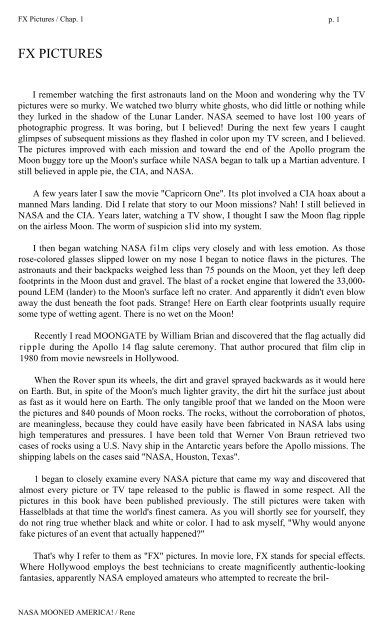Rene-NASA-Mooned-America
Rene-NASA-Mooned-America
Rene-NASA-Mooned-America
You also want an ePaper? Increase the reach of your titles
YUMPU automatically turns print PDFs into web optimized ePapers that Google loves.
FX Pictures / Chap. 1 p. 1<br />
FX PICTURES<br />
I remember watching the first astronauts land on the Moon and wondering why the TV<br />
pictures were so murky. We watched two blurry white ghosts, who did little or nothing while<br />
they lurked in the shadow of the Lunar Lander. <strong>NASA</strong> seemed to have lost 100 years of<br />
photographic progress. It was boring, but I believed! During the next few years I caught<br />
glimpses of subsequent missions as they flashed in color upon my TV screen, and I believed.<br />
The pictures improved with each mission and toward the end of the Apollo program the<br />
Moon buggy tore up the Moon's surface while <strong>NASA</strong> began to talk up a Martian adventure. I<br />
still believed in apple pie, the CIA, and <strong>NASA</strong>.<br />
A few years later I saw the movie "Capricorn One". Its plot involved a CIA hoax about a<br />
manned Mars landing. Did I relate that story to our Moon missions Nah! I still believed in<br />
<strong>NASA</strong> and the CIA. Years later, watching a TV show, I thought I saw the Moon flag ripple<br />
on the airless Moon. The worm of suspicion slid into my system.<br />
I then began watching <strong>NASA</strong> film clips very closely and with less emotion. As those<br />
rose-colored glasses slipped lower on my nose I began to notice flaws in the pictures. The<br />
astronauts and their backpacks weighed less than 75 pounds on the Moon, yet they left deep<br />
footprints in the Moon dust and gravel. The blast of a rocket engine that lowered the 33,000-<br />
pound LEM (lander) to the Moon's surface left no crater. And apparently it didn't even blow<br />
away the dust beneath the foot pads. Strange! Here on Earth clear footprints usually require<br />
some type of wetting agent. There is no wet on the Moon!<br />
Recently I read MOONGATE by William Brian and discovered that the flag actually did<br />
ripple during the Apollo 14 flag salute ceremony. That author procured that film clip in<br />
1980 from movie newsreels in Hollywood.<br />
When the Rover spun its wheels, the dirt and gravel sprayed backwards as it would here<br />
on Earth. But, in spite of the Moon's much lighter gravity, the dirt hit the surface just about<br />
as fast as it would here on Earth. The only tangible proof that we landed on the Moon were<br />
the pictures and 840 pounds of Moon rocks. The rocks, without the corroboration of photos,<br />
are meaningless, because they could have easily have been fabricated in <strong>NASA</strong> labs using<br />
high temperatures and pressures. I have been told that Werner Von Braun retrieved two<br />
cases of rocks using a U.S. Navy ship in the Antarctic years before the Apollo missions. The<br />
shipping labels on the cases said "<strong>NASA</strong>, Houston, Texas".<br />
1 began to closely examine every <strong>NASA</strong> picture that came my way and discovered that<br />
almost every picture or TV tape released to the public is flawed in some respect. All the<br />
pictures in this book have been published previously. The still pictures were taken with<br />
Hasselblads at that time the world's finest camera. As you will shortly see for yourself, they<br />
do not ring true whether black and white or color. I had to ask myself, "Why would anyone<br />
fake pictures of an event that actually happened"<br />
That's why I refer to them as "FX" pictures. In movie lore, FX stands for special effects.<br />
Where Hollywood employs the best technicians to create magnificently authentic-looking<br />
fantasies, apparently <strong>NASA</strong> employed amateurs who attempted to recreate the bril-<br />
<strong>NASA</strong> MOONED AMERICA! / <strong>Rene</strong>


